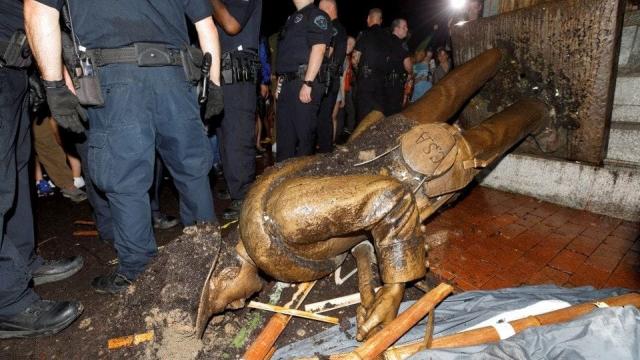
University of North Carolina-Chapel Hill police surround the toppled statue of a Confederate soldier, nicknamed “Silent Sam,” on the school’s campus after a demonstration for its removal on Monday. (Jonathan Drake/Reuters)
Protesters clashed Saturday at the University of North Carolina at Chapel Hill — resulting in several arrests — a few days after a group toppled a Confederate soldier’s bronze statue that was erected on campus more than a century ago.
Some protesters held Confederate flags while others chanted, “White supremacy’s got to go, hey hey ho ho!” Police arrested seven people, many of whom were charged with assault.
The arrests capped off a week of simmering tension that began Monday evening, when dozens of protesters showed up at UNC-Chapel Hill, gathered around the “Silent Sam” statue of the anonymous Confederate soldier and pulled it down with a rope. University spokesman Randy Young said police have filed warrants on three people for damaging the statue. These three, who aren’t affiliated with the university, are each facing misdemeanor riot and misdemeanor defacing of a public monument charges. Young said he can’t confirm if the three had been arrested.
Another person was arrested Monday for hiding their face during the protest. Hiding or disguising one’s face during a protest is illegal in North Carolina.
The week’s events unfolded as cities across the country grapple with Confederate monuments, which have been the subject of confrontations between those who see the statues as reminders of racism and slavery and others who believe they should be kept and preserved. The statue that was torn down Monday, called “Silent Sam,” had been vandalized in recent months, while officials have debated about what to do with three other Confederate statues at the North Carolina Capitol grounds in Raleigh.
In a phone conference with reporters earlier this week, Chancellor Carol Folt said the toppled statue has been “a flash point and a divisive symbol for decades.” But she added that regardless of how people feel about Confederate monuments, “what happened on Monday night was destruction of state property and that is not lawful.”
University officials said earlier that they were expecting a protest on campus Saturday and urged students to not attend. None of those who were arrested Saturday are affiliated with the university, officials said.
“We do not know for sure what groups may attend, but we are mindful that the current atmosphere is highly charged, and protests that begin peacefully do not always remain that way,” officials said in a statement.
One Chapel Hill police officer attracted some controversy after he was photographed standing guard in front of Silent Sam during Monday’s protest and displaying a “We the People” arm tattoo, which symbolizes the group known as Three Percenters, which pledges armed resistance against the government’s curtailing of constitutional rights, specifically the Second Amendment. Chapel Hill Police Chief Chris Blue said the officer regrets “that his tattoo has been associated with groups that perpetuate hate and violence.”
“We understand the concerns regarding the negative interpretations of the tattoo and regret it was displayed,” Blue said. “This will not occur again.”
Silent Sam was erected at UNC-Chapel Hill in 1913 and was given to the university by the United Daughters of the Confederacy four years earlier. The statue was in remembrance of “the sons of the University who died for their beloved Southland 1861-1865,” according to the university website. The statue has long been the subject of hatred and admiration, like other Confederate monuments. During the statue’s dedication, the chairman of a monument committee said: “In honoring the memory of our Confederate heroes, we must not be misunderstood as having in our hearts any hatred to those who wore the Blue, but we do not wish to forget what has been done for us by those who wore the Gray.”
About 30 miles away, in Raleigh, the North Carolina Historical Commission on Wednesday said three Confederate monuments at the state Capitol were “an overrepresentation and over-memorialization of a difficult era” in North Carolina’s history. But the commission said state law keeps it from recommending the removal or relocation of the monuments. The commission, instead, said additional signage with historical context should be added adjacent to the monuments.
Originally published by The Washington Post












